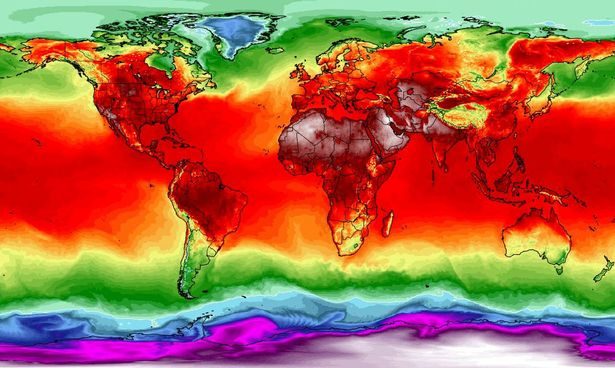
The 14-day heatwave is the longest the country has enjoyed since the summer of 1976, but health warnings have been issued for young children and over-65s
As the country basks in its longest heatwave since 1976, Met Office forecasters say temperatures will feel a lot cooler next week.
The forecast for today shows temperatures around London could reach as as high as 33, a potential record for the two-week heatwave .
The west country is likely to also have very hot weather, with another sticky night ahead in the south.
The Met Office says Monday will still be very warm in the south with plenty of sunshine and fine weather while the north of England will be bright and warm too but less warm than today, especially in the northeast.
The outlook for Tuesday to Thursday shows temperatures across the country will be little cooler with more in the way of cloud, but staying mostly dry.
There is the chance of some light rain in the far north at times with showers possible in the west Thursday.
Friday looks set to be dry and warm again across many parts of the UK though there may be a few showers.
Next weekend looks like staying mainly warm and fine for the World Cup final, although there will potentially be more cloud around than this weekend with perhaps a few showers.
The following week, the weather may well turn more changeable according to the Met Office and will be somewhat cooler.
There will be an increasing chance of showers, possibly thundery in the south, and bands of cloud and rain and stronger winds are likely from the northwest, weakening as they move southeastwards.
However, there will still be a good deal of fine and sunny weather, the best of this most likely in the southeast.
Porthmadog in Wales is the current record holder for hottest temperature of the year, reaching 33C on June 28.
The Met Office and Public Health England (PHE) upgraded their heatwave alerts for western regions of England on Thursday to amber and extended the current alerts through to the middle of next week.
A yellow alert is in place for eastern regions.
For those aged 65 and over, young children and those with heart and lung conditions can all find normal activities a strain when temperatures get this high.
High temperatures, indoors and outdoors can also pose a risk to everyone's health over such a sustained period.
The hot weather has now been in place for two weeks and we are seeing an increase in the number of people who are attending GP surgeries and calling NHS 111 for heat related conditions such as sunburn, sunstroke, heatstroke and insect bites.
Dr Thomas Waite of PHE said: "While many of us will be enjoying the hot weather over the next few days, for some it can pose a real health risk.
"So it is critically important that we keep an eye on friends, family and neighbours who may be at risk.
"To stay cool, avoid the sun during the hottest parts of the day, carry water with you when travelling and think what you can do stay cool when going to large events.
"It's also worth remembering to think about practical steps to keep your home cool during the day as this can aid sleeping at night and give the body time to recover from the heat.
"Close curtains on rooms that face the sun to keep indoor spaces cooler and remember it may be cooler outdoors than indoors."
A world heat map compiled by the University of Maine shows temperatures soaring across the planet.
North America, Europe, the Middle East and western Asia have all seen heat records broken in the past week due to huge areas of pressure called heat domes.



Comment: See also: